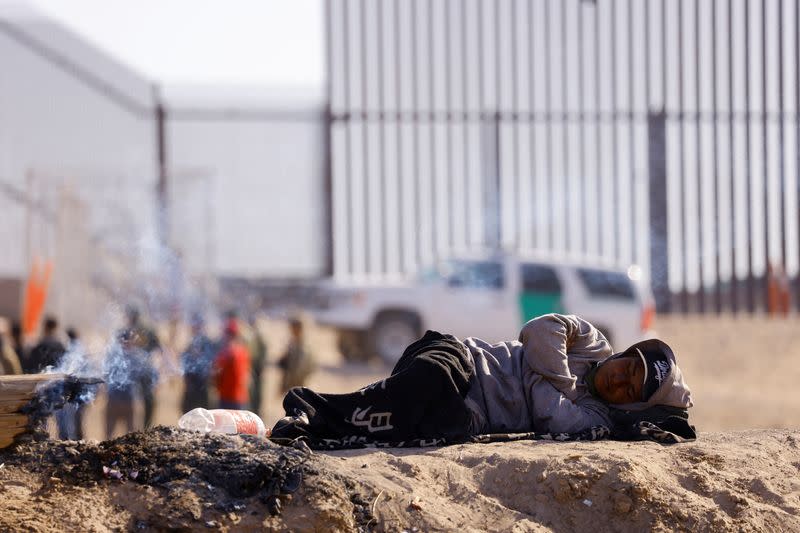US prepares for more migrant crossings as border restrictions set to end

- Oops!Something went wrong.Please try again later.
By Ted Hesson and Matt Spetalnick
WASHINGTON (Reuters) -President Joe Biden's administration is devising a strategy for the possible arrival of tens of thousands more migrants at the U.S.-Mexico border after the anticipated end of COVID-19 restrictions next month, scrambling to find holding centers, speed deportations and increase processing of refugees abroad.
The administration is expected to announce new measures as soon as this week that would include stepping up the number of Latin Americans admitted through the U.S. refugee settlement program, three people familiar with the matter told Reuters.
U.S. officials are also expanding holding capacity for migrants at the border while piloting faster asylum screenings. One yet-unreported option under discussion is to process migrants at Fort Bliss, a military base near El Paso, Texas, two U.S. officials and a third person familiar with the matter told Reuters. The base was used to house thousands of unaccompanied minors in 2021, which led to reports of overcrowding and unsanitary conditions.
White House spokesperson Abdullah Hasan denied Fort Bliss was being considered and the Pentagon said it had not received a request to use it for migrant processing.
Other steps are likely to include agreements with regional governments aimed at curbing migration and increasing aid to migrants already in those countries, according to the person familiar with the matter, although details remain unclear.
Barring any last-minute legal or congressional intervention, the Biden plans aim to address a likely increase in unauthorized immigration after May 11, when COVID border restrictions in place since 2020 are set to end.
The broader COVID public health emergency is scheduled to terminate on that date, undercutting the rationale for the restrictions, known as Title 42.
The U.S. Department of Homeland Security (DHS) and U.S. State Department did not respond to requests for comment.
United Nations agencies that assist with refugee processing in Latin America said they were in discussions with Washington about increasing resettlement from the region.
At the same time, 480 U.S. Citizenship and Immigration Services (USCIS) employees with refugee experience are being assigned to help with initial asylum screenings of migrants caught at the border, a union representative said on Wednesday.
The representative, Michael Knowles, said that even with the temporary boost in workers, the asylum program is "vastly understaffed and under-resourced" with about 800 permanent asylum officers.
LOW REFUGEE ADMISSONS
Biden, a Democrat who announced his 2024 re-election campaign this week, has struggled with record numbers of migrants caught crossing the U.S.-Mexico border and gradually toughened his approach to enforcement. Republicans have criticized Biden for abandoning hardline policies championed by former President Donald Trump, the leading candidate for their party's presidential nomination.
The Biden administration has yet to restore refugee admissions slashed under Trump.
Biden carved out 15,000 refugee slots for people in Latin America and the Caribbean in fiscal year 2023, which began on Oct. 1, 2022, but only admitted about 2,300 as of March 31.
Biden officials have discussed expanding refugee processing in Guatemala and Colombia, three sources familiar with the matter said. Ecuador and Costa Rica are also under consideration, one of the sources said.
Government representatives from those nations did not immediately respond to requests for comment.
In addition to the refugee efforts, Biden's latest border plan focuses on a soon-to-be-finalized regulation that would block most migrants crossing the U.S.-Mexico border illegally from claiming asylum if they passed through another country without seeking refuge or failed to use legal U.S. pathways.
U.S. authorities have said people denied asylum under the new regulation will be subject to "prompt removal," which could deter other border crossers but may prove logistically challenging.
Troy Miller, acting commissioner of U.S. Customs and Border Protection (CBP), told lawmakers last week he is preparing for the possibility that up to 10,000 migrants per day could attempt to enter the United States illegally, nearly double the daily average in March. Miller noted that an estimated 660,000 migrants are currently in Mexico, citing United Nations figures.
CBP has capacity to detain 6,000 migrants at the U.S.-Mexico border and plans to add space for 2,500 more, Miller said, adding that the agency has stepped up its ability to quickly transport migrants away from the border.
Border cities have struggled with large numbers of migrants releases in the past.
(Reporting by Ted Hesson and Matt Spetalnick in Washington; Additional reporting by Sofia Menchu in Guatemala City, Alvaro Murillo in San Jose, Daina Beth Solomon in Mexico City; Julia Symmes Cobb in Bogota, and Alexandra Valencia in Quito; Editing by Mary Milliken, Mica Rosenberg, and David Gregorio)

